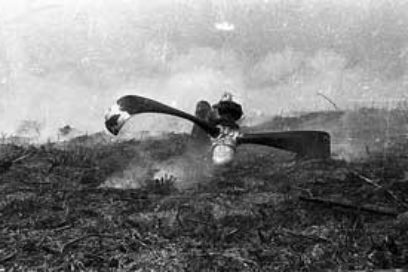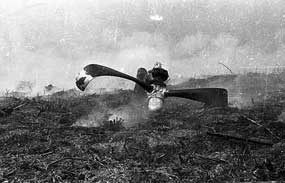Havana, (Prensa Latina).- Cuba is commemorating today the 53rd anniversary of the bombings of its airports, ordered by the government of the United States and resulting in the prelude of the mercenary invasion that was defeated in record time in Playa Giron (Bay of Pigs).
The commemoration is taking place at a time when evidence shows new modalities of aggression against Cuba, described as non-conventional warfare in a training handbook of the Special Operation Forces of the U.S. Army.
At the dawn of Saturday, April 15, 1961, enemy planes camouflaged as aircraft of the recently-founded Revolutionary Armed Forces, attacked the airport in Ciudad Libertad (in the capital), the air base in San Antonio de los Baños (southeast of Havana) and the airport in the eastern city of Santiago de Cuba.
Eight B-26 planes departed from Puerto Cabezas, Nicaragua, with the mission of destroying, on the ground, Cuba’s modest aviation and guaranteeing the impunity of other incursions.
A fleet, armed and financed by the U.S. government had departed from that Nicaraguan city, carrying a mercenary brigade whose mission was to occupy a beachhead from where they would announce the establishment of a puppet government.
The air strike that day aimed to make international public opinion think that an internal uprising was taking place in Cuba.
In order to achieve that goal, one of the planes camouflaged with the insignias of the Revolutionary Armed Forces would land in Miami to validate the hypothesis that Cuban pilots were deserting. That perfidious attack took many lives of civilians and revolutionary combatants.
Despite the surprise, the artillery brought down one of the enemy planes. Two others were hit and had to land in Key West and Grand Cayman.
That same day, Cuban Foreign Minister Raul Roa denounced the air strike and the possibility of a large-scale aggression at the United Nations General Assembly.
His U.S. counterpart, Adlai Stevenson, made a fool of himself, the same way as Secretary of State Colin Powell did years later when he had to defend the «evidence» fabricated by the government of President George W. Bush to justify the armed invasion of Iraq.
Comparisons are not made by chance. In April 1961, the organization of an invasion of Cuba was accompanied by a ferocious campaign of slanders and destabilization that involved several agencies and departments of the U.S. government.
Radio stations, newspapers and news agencies imposed a matrix that distorted Cuba’s situation and satanized the leaders of the Revolution.
It also consisted of measures of economic blockade against Cuba to create destabilization and unrest among people.
These elements of non-conventional warfare are described in the training handbook TC 18-01 of the Special Operation Forces (SOF) of U.S. Army.
One of the objectives is to divide society and have an influence on sectors such as young people to turn them into opponents of the recognized authorities. That was precisely the objective of the program ZunZuneo, which was funded through the U.S. Agency for International Assistance (USAID) and was implemented against Cuba from 2009 to 2012.
Through USAID, contracting companies and foreign banks, a platform of Twitter-like messages for Cuba was put in place to influence young people.
The revelations by the Associated Press on the secret program ZunZuneo were like Pandora’s Box and revealed the plans to try to change institutional order in Cuba.
«The new element here is the use of new technologies, particularly communications,» said Jesus Arboleya, a diplomat, academic and expert in relations between Havana and Washington, in statements to Prensa Latina.
The new modalities of non-conventional warfare against Cuba are part of the strategy that Washington has implemented since the very triumph of the Revolution, said Arboleya, author of the book «El Otro Terrorismo: Medio Siglo de Política de los Estados Unidos hacia Cuba» (The Other Terrorism: Half a Century of U.S. Politics on Cuba).
Those actions match the so-called Fourth Generation War, as well as the so-called «soft coup» that the administration of President Barrack Obama is carrying out in several regions of the world, including Cuba, the Middle East, Ukraine and Venezuela.
Such a strategy includes the use of all resources to discredit governments and create an opposition critical mass that «most times it does not know whom it serves or whose interests it represents», noted Arboleya.
«These events confirm that wherever there is a government that does not meet the interests of the circles of power of the United States and some of its European allies, it becomes a target of subversive campaigns,» said Cuban President Raul Castro on February 22, 2014, at the closing session of 20th Congress of the Confederation of Cuban Workers (CTC).
Both today and in April 1961, Cuba is still the target of the United States, whose debacle during the Playa Giron invasion is considered here the first defeat of Yankee imperialism in Latin America.



